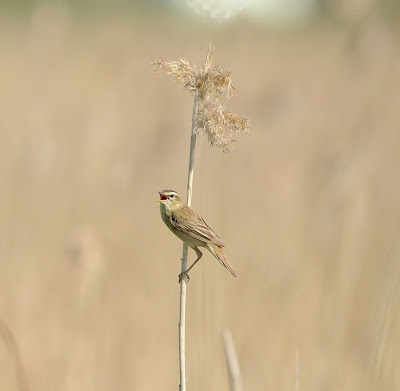Here in coastal Lancashire we’ve had no rain for four weeks and the summer is beginning to look like an old-fashioned one but where the inevitable thunderstorms are due this evening and into Sunday. This should remind us that this is Britain and not the Sahara Desert.
It’s similar across the country where millions of people are out enjoying the weather, despite the UK Nanny State who think that the public cannot understand a weather forecast so choose to bombard us with Health Heat Alerts to ramp up the global warming scare at every bit of sunny weather. They really do take us for fools who they can continually scare, manipulate and thus control.
On my Pilling travels on Friday it was hard to miss the dried out landscape and the lack of rain puddles in familiar places. Birds were laying low, many feeding young and others simply hard to find.
Along a track lined with reeds and vegetation I found Common Whitethroat and Sedge Warbler, both still in song and seemingly yet to reach the stage of collecting food for nestlings.
The breeding year was slow to start, an April and early May of cold northerlies and late arrivals of African migrants. Even now there appears to be a shortage of Reed Buntings, House Martins, Swifts, Swallows and even Wrens. Those of us close to the action think that there could be Avian Flu in passerines and small birds. But how would we know when millions of small birds die of both natural and unnatural causes and then simply go missing never to be found?
The Whitethroat is pictured against a green background of newly growing maize crop, the Sedge Warbler against a freshly cut and now parched field of silage. The bokeh of the Sigma lens is really good at most times.
Sedge Warbler
Whitethroat
A couple of Lapwings inspected in turn a newly sown seed plot and then a two inch high maize crop. The Lapwings may have failed their first attempt at raising a family so may return and lay in what appears ideal and now undisturbed spots. If we get rain both crops will thrive and grow like giant beanstalks so it’s a hard decision for the Lapwings.
Little Egrets have been thin on the ground just locally until one appeared below my slowly moving car hide. Along another ditch a Buzzard stood sentinel and then took off to circle and find the rising thermals.
Little Egret
Buzzard
The cut silage field had half a dozen Curlews scratching a living on the rock hard ground. Even in the height of summer it is not difficult to find handfuls of upland waders that return quickly to the coast when their upland adventures turn sour. Soon there will be masses of both and it will be interesting to see how the inland wader season fared. Just last week Curlews gave me a hard time and something of the run-around when I tried to picture them in their other world, the uplands of the Pennine Hills.
Curlew
I found a couple of Oystercatchers hanging around on gate posts where they seemed unconcerned at my being close by as if they had no young in tow.
Oystercatcher
Once the rain leaves us there's a visit to the Sand Martin colony planned mid week. We need a light easterly and not much sun that will light up our mist nets.
Log in soon folks. And enjoy the sun. Winter will come soon enough. You know it makes sense.
Linking today to Eileen's Blogspot.














.jpeg)






.jpg)













7 comments:
Hello Phil,
It has been dry here for months now, we've only had a tiny bit of rain. This week we have had daily alerts due to the smoke and haze which came down from the Canada wildfires. You posted a great variety of birds, a few of my favorites are the Lapwing, Buzzard and Curlew! Great collection of photos.
Thank you for linking up and sharing your post. Take care, have a great weekend.
The Lapwing is a gorgeous bird and I love seeing all the birds you have there that we don't have here. I had a friend write me...STAY inside! If I start staying inside now....it's going to be a long summer! lol Enjoy your weekend!
I haven't checked the records, but it "feels" as if our wet season started a bit late this year as well. That has now changed and we're having afternoon thunderstorms roll through on a regular basis. Accordingly, our brown landscape turned green almost ovenight.
Despite your conditions, you managed to locate a diverse group of subjects! An Oystercatcher on a gate post just seems strange to me.
Here's hoping your Sand Martin colony visit will be a good one!
I always worry about the wildlife when the weather is bad like droughts. I've wondered where do they hide when tropical storms are coming here in Florida. They know when the pressure changes and everybody disappears until the storm is past.
I've seen oystercatchers in the US but I remember them has having more orange. I wonder if this is another example - like robins and goldfinches - of birds with the same names which have a totally different appearance across the pond?
Thanks for sharing at https://image-in-ing.blogspot.com/2023/06/briam-mmmm-good.html
Love the variety of birds you photographed.
I especially love the Lapwing.
Happy Wednesday, Phil.
Great shots! It’s been dry here in Virginia, plus we had several days of air pollution from smoke that drifted down from Canadian wildfires. We have a chance of rain today and I see that wind is blowing.
Post a Comment